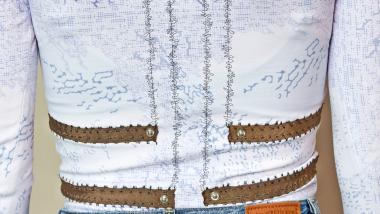Wearables for healthcare: sensors to wear
Stylish sensors to wear
With sensors that measure health parameters and can be worn on the body, we do let technology get very close to us. A collaboration between Empa and designer Laura Deschl, sponsored by the Textile and Design Alliance (TaDA) of Eastern Switzerland, shows that medical monitoring of respiratory activity, for example, can also be very stylish – as a shirt.
With sensors that measure health parameters and can be worn on the body, we do let technology get very close to us. A collaboration between Empa and designer Laura Deschl, sponsored by the Textile and Design Alliance (TaDA) of Eastern Switzerland, shows that medical monitoring of respiratory activity, for example, can also be very stylish – as a shirt.
The desire for a healthy lifestyle has triggered a trend towards self-tracking. Vital signs should be available at all times, for example to consistently measure training effects. At the same time, among the continuously growing group of people over 65, the desire to maintain performance into old age is stronger than ever. Preventive, health-maintaining measures must be monitored if they are to achieve the desired results. The search for measurement systems that reliably determine the corresponding health parameters is in full swing. In addition to the leisure sector, medicine needs suitable and reliable measurement systems that enable efficient and effective care for an increasing number of people in hospital and at home. After all, the increase in lifestyle diseases such as diabetes, cardiovascular problems or respiratory diseases is putting a strain on the healthcare system.
Researchers led by Simon Annaheim from Empa's Biomimetic Membranes and Textiles laboratory in St. Gallen are therefore developing sensors for monitoring health status, for example for a diagnostic belt based on flexible sensors with electrically conductive or light-conducting fibers. However, other, less technical properties can be decisive for the acceptance of continuous medical monitoring by patients. For example, the sensors must be comfortable to wear and easy to handle – and ideally also look good.
This aspect is addressed by a cooperation between the Textile and Design Alliance, or TaDA for short, in eastern Switzerland and Empa. The project showed how textile sensors can be integrated into garments. In addition to technical reliability and a high level of comfort, another focus was on the design of the garments. The interdisciplinary TaDA designer Laura Deschl worked electrically conductive fibers into a shirt that change their resistance depending on how much they are stretched. This allows the shirt to monitor how much the subjects' chest and abdomen rise and fall while they breathe, allowing conclusions to be drawn about breathing activity. Continuous monitoring of respiratory activity is of particular interest for patients during the recovery phase after surgery and for patients who are being treated with painkillers. Such a shirt could also be helpful for patients with breathing problems such as sleep apnea or asthma. Moreover, Deschl embroidered electrically conductive fibers from Empa into the shirt, which are needed to connect to the measuring device and were visually integrated into the shirt's design pattern.
The Textile and Design Alliance is a pilot program of the cultural promotion of the cantons of Appenzell Ausserrhoden, St.Gallen and Thurgau to promote cooperation between creative artists from all over the world and the textile industry. Through international calls for proposals, cultural workers from all disciplines are invited to spend three months working in the textile industry in eastern Switzerland. The TaDA network comprises 13 cooperation partners – textile companies, cultural, research and educational institutions – and thus offers the creative artists direct access to highly specialized know-how and technical means of production in order to work, research and experiment on their textile projects on site. This artistic creativity is in turn made available to the partners as innovative potential.
EMPA


